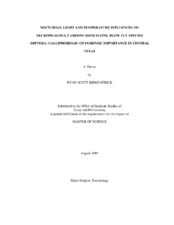| dc.description.abstract | It is commonly thought that blow flies are nocturnally inactive. Blowflies are often important in helping to estimate post mortem intervals (PMI) for corpses found at death scenes. If blow flies oviposit during nocturnal hours, there could possibly be up to 12-hour discrepancies for estimates of PMI.
Two blow fly species, Phaenicia eximia (Wiedemann) and Cochliomyia macellaria (F.), oviposited nocturnally on ground beef baits in 2003, during the onset of low-atmospheric pressure (an air mass with lower atmospheric pressure than that of the air surrounding it) at rural study sites near Snook (Burleson County), Texas, under artificial lighting of at least 1500 footcandles when temperatures were at 26?C or higher. Trials conducted under similar conditions during the same year without a low-pressure system moving into the area resulted in no nocturnal blow fly oviposition.
Nocturnal blow fly oviposition went undetected once low-atmospheric pressure systems settled into the study area, irrespective of temperature and lighting conditions. Thus, this study illustrates that there is a connection between the onset of low-atmospheric pressure and nocturnal blow fly oviposition on baits under artificial lighting of 1500 footcandles or more when temperatures are 26 ?C or above.
After concluding 2003 experiments, statistical analyses supplied evidence that woodland habitat was more favorable for blow fly oviposition than prairieland habitat throughout the 2003 study, irrespective of species or time of year. Furthermore, statistical analyses conducted on nocturnal and diurnal temperature ranges furnished evidence to support the hypothesis that 2003 nocturnal temperatures had more of an effect on daily ovipositing than diurnal temperatures for P. eximia and Cynomyopsis cadaverina (Robineau-Desvoidy). | en |


